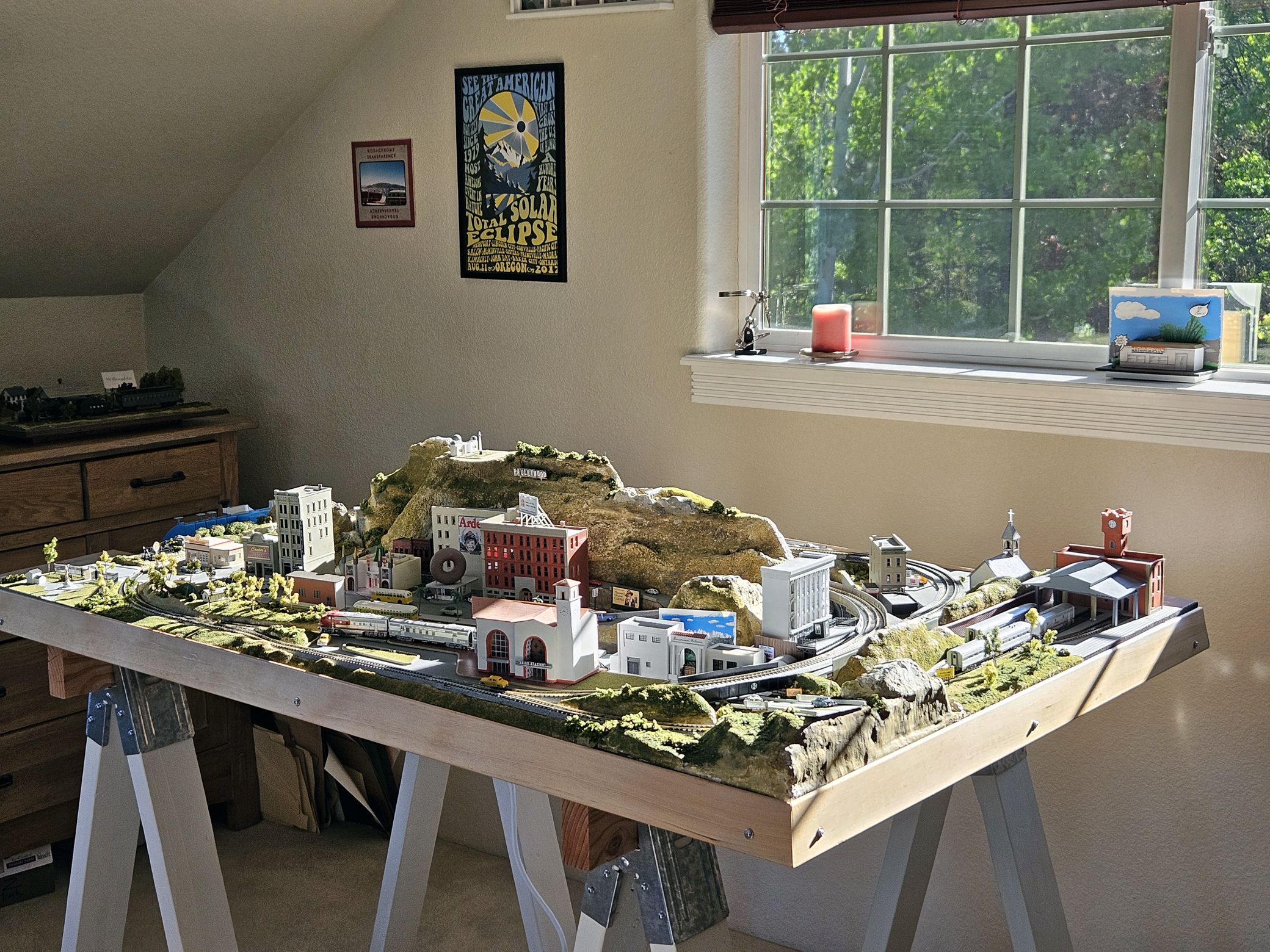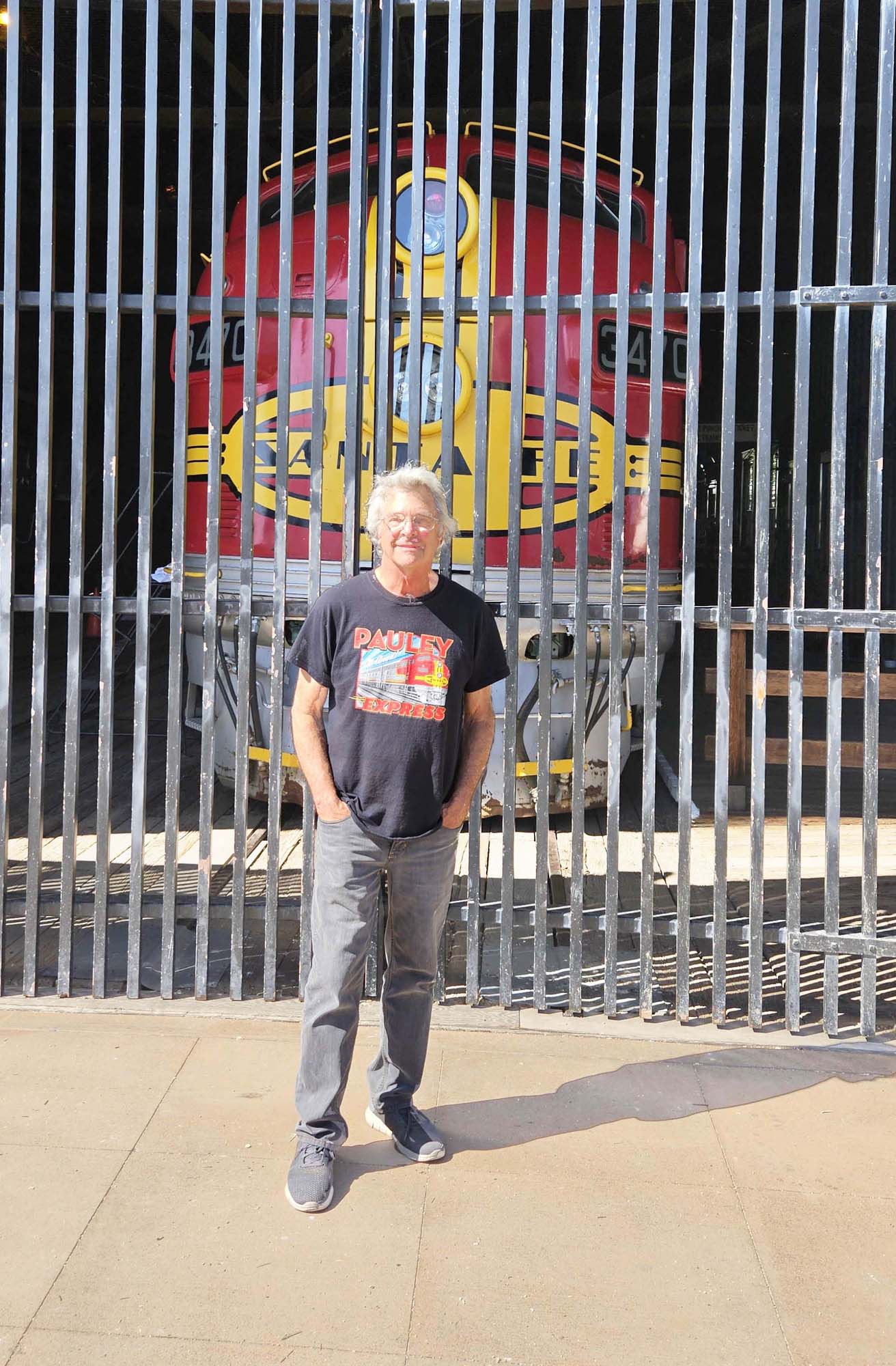Celebrating the Super Chief
A Summary
October 2024
I’ve reached a milestone. I don’t want to promise that this layout is complete, but all the major components and details are in place. And while I’ll probably continue to “tweak,” I thought this would be a good time for a summary and tour.
Note that the planning and construction of individual sections have been detailed on the Layouts pages 10-13. But I wanted to share some perspectives that weren’t provided previously.
Celebrating the Super Chief is the second train layout I have constructed, the first being a slightly altered version of the small town of Grants Pass where I reside. Information about that layout can be found on Layout pages 1-4. I’ve also created a number of stand-alone dioramas, detailed on Layout pages 5-9.
One of the greatest challenges I had with both major layouts is the fact that I did not have anything even close to a complete plan in mind when I started them. As such, I just “went with the flow,” building what I felt inspired to create, so as I filled the layouts, it became more challenging to appropriately utilize the decreasing space in a logical way. I’m pretty pleased how it all turned out.
If you’ve read the first few pages of the web site, you know that unlike many if not most model railroaders, I do not seek to build extremely realistic layouts. Mine are, in many ways, like an abstract sculpture that has some functionality. Early on in this hobby, I realized that ignoring reality can be very liberating. It’s that theory that allows 1970s Chicago to comfortably share space with 1950s Los Angeles, or a Boston trolley car to pass through Grants Pass, Oregon. (Avoiding reality has also helped to keep me calm these past few years.)
The Super Chief
Since I first started to read about it, I could feel the romance of the famous Santa Fe Super Chief. Known as “the train of the stars” because of all the celebrities that were regular passengers, it travelled between Chicago and Los Angeles from the late 1930s to the mid-70s. (More history here.)
Of course, the train evolved over the years. My favorite train configuration (and the one I chose to model) is from the early 50s. In 1951 (the year I was born) the Santa Fe introduced streamlined cars as well as a two-level observation car known as the “Pleasure Dome.”
Although automobiles, a new highway system, and, of course, the airline industry were already starting to whittle away at passenger train travel, the Super Chief at that time was probably the most comfortable way to go across the country. I fantasize how neat it must have been to board in a freezing-cold Chicago and, after traveling a day and half in modern comfort, ending the trip in glamorous, balmy Los Angeles of the early 1950s.
Let’s go for a tour of the layout.
Los Angeles
Since I spent almost 40 years in Los Angeles, it is only natural that it fills the most real estate on this layout. The theoretical entrance is a sloping freeway at the front, right corner. It was actually one of the last sections I completed. As such, I had to take some abstract liberties such as a ridiculously steep road angle, and a lift-off section to allow for trains heading to and from Dearborn Station. But I think it gives the rest of the layout a good “flavor,” if you know what I mean.
Nearby Paramount Pictures was also added rather late in the layout’s development. I just happened to have a small, unused area adjacent to Union Station. The buildings that I had made and used as placeholders wound up being part of the studio.
Placing the studio there meant that it was right next to Chicago. Just for the fun of it, I got a little sneaky and made it look like Chicago was a set on the back lot. A little sign reads “Coming Soon – Sweet Home Chicago.”
Union Station was one of the first buildings I constructed for this layout. It was actually built to fit on my originally planned shelf layout. (That’s why it’s kind of a funny shape.) But I think it works here just fine.
Also making an appearance on a dark and dingy street is the Nite Owl Coffee Shop from the Movie LA Confidential. Above Los Angeles is Griffith Park Observatory as well as the not-yet-famous Pauleywood Sign. Some family ties have been included in Los Angeles. They include the Arden Dairy sign, the Barker Brothers Building and Forest Lawn. You can read the details of those and other locations on Layouts, page 13. Orange Groves The postcard below was the inspiration for including orange groves. In the 1950s, Southern California was home to thousands of orange groves. They were a symbol of wealth and luxury in the region. It’s no wonder that the Santa Fe used photos of the groves in its advertising, enticing folks to come to southern California. | |||
I had a relatively small space to fill between the California desert and Chicago, so I was able to include just a few tidbits. Many years ago, I spent some time in Bullhead City, Arizona, along the Colorado River. Nearby Davis Dam, completed in 1951, created Lake Mohave, a wonderful desert destination, and a neat place to water ski. I wanted to include it. | |||
When I was thinking about building a shelf diorama, I did a little test to see how to do New Mexico’s colors and pueblos with Route 66 close by. I was happy the way it turned out, and I realized that I could incorporate that test on the layout, adding a small version of Arizona next to it. Kansas The other area I added was a very tiny representation of Kansas. I wanted to include farms, but it is so small that I had to create the smallest structures I ever made to represent farm buildings, and even a windmill.
Chicago As I explained on the Layout pages, the only things I knew about Chicago is what I’ve seen in The Blues Brothers movie. So rather than trying to depict Chicago of the 1950s, I created a separate diorama in homage to one of my favorite films. If you are not familiar with the movie, this might be a somewhat boring section of the layout. But fans who can recite the dialog (like me), will appreciate the location details. They include the Plymouth Hotel, with the Dill Pickle Deli on the corner and Elwood’s secret garage out back; the Triple Rock Church; Ray’s Music Exchange; Curl up and Dye Hair Salon (many fans don't know that name); Howard Johnson’s (with nearby propane tank and phone booth), Lower Wacker Drive (inlcuding "that Picasso") and, of course, Bob’s Country Bunker (with its lighted sign). By the way, the real Picasso at Daley Plaza is an abstract of a dog. I chose a cat abstract as a substitute. Take a peek at Layouts page 11 for a few more tidbits. | |||
|
| ||
|
| ||
"Hey, that's where they got "Yup." |
|||
I also included a small version of Dearborn Station, the eastern terminus of so many Santa Fe trains, including, of course, the Super Chief. | |||
|
|||
Named trains were very special in the heyday of passenger rail travel. Railroads would sometimes put new cars on display and allow the public to tour them. Using a picture that I found in a book about the Santa Fe as a guide, I took the liberty of setting up a display outside of Dearborn Station. I figured since I couldn’t really run full length trains on this layout, this would be a way to display some of the other cars. (The Kato Super Chief cars are very nicely detailed.)
Santa Fe Paraphernalia During my Santa Fe adventure, I’ve collected a few (well, maybe a bit more than a few) trinkets including books, pictures, signs, postage stamps, pins, cups, and other related paraphernalia. I thought I’d wrap up this project by posting some pictures here. | |||
|
|||
|
| ||
Well, that’s about it – for now. I don’t know what my next project will be, but stay tuned. Remember, the only rule that's important is to have fun!
| |||
| |||
































